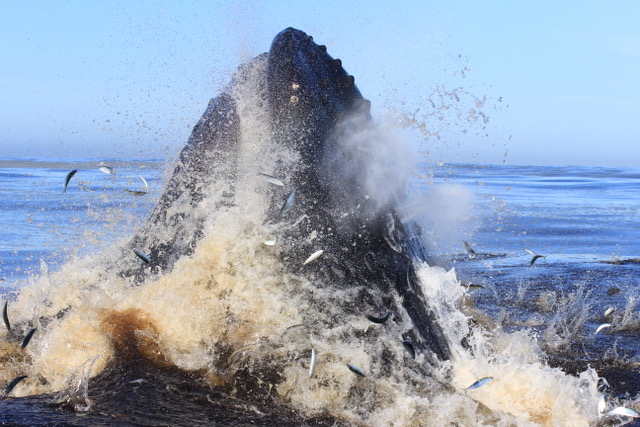 Evolution & Behaviour
Evolution & Behaviour
Sneaking Giants: how humpback whales avoid scattering their fish prey
Why do speedy, agile anchovies fall prey to humpback whales, when they are able to escape faster predators? This study explained this phenomenon using field, lab and modelling studies. By controlling their speed and precisely timing the opening of their massive mouth, humpbacks are able to sneak up on fish schools without scattering them.

Small prey animals are generally much slower than the predators attacking them, but have a distinct advantage that can help them escape: maneuverability. When a prey observes a predator approaching, the change in the predator's visual profile gives it a good idea of the size and speed of its attack. While the prey is unlikely to be able to outrun the larger predator, it can turn in a different direction more rapidly and use this to escape. Think of a rabbit trying to evade a dog, or an impala evading a cheetah. For schooling fish, this can be seen as a scattering of the fish when predators attack: they flee in all directions, and the larger prey often cannot match these sharp turns.
For humpback whales this poses a problem. Since accelerating its huge bulk is very energetically costly, and its maneuverability is very low, the effort needs to be worth it. So how does a huge humpback avoid scattering a school of anchovies that can see it coming, and catch enough fish to make the effort worthwhile? This is even more puzzling when we noticed that in some cases humpback whales even slow down when approaching a fish school.
Our study approached this question through a combination of field, lab and modelling studies. Firstly, we attached tracking tags to humpback whales feeding on krill and anchovies off the coast of California. These tags attach via rubber suction cups and fall off after a few hours, and they contain a variety of sensors: cameras, accelerometers, microphones, depth gauges, and more. These reveal how whales feed on different prey: how fast they attack and when exactly they open their mouths to engulf the prey. Next, we created animations that simulate the size and speed of an attacking whale from the perspective of an anchovy, and played this animation to anchovies in the lab. Amazingly enough, anchovies perceive this animation as a potential predator coming towards them and try to escape from it. Using high-speed video analysis of when the anchovies tried to escape from the simulated threat, we determined the thresholds of predator size, speed and distance at which they respond. We modelled different scenarios to determine when anchovies would escape from an attacking humpback whale, how many would be caught, and the energetic benefits the whale would get given the costs of its attack.
Counter-intuitively, we found that humpback whales can mask their approach during attacks by approaching the prey at a relatively low speed. As a result, their apparent diameter doesn't change very quickly as they approach the fish, unlike that of smaller, quicker, predators. The whales use this to their advantage by being able to creep up close to the school without scattering it - until they open their mouth. By then it is usually too late for the fish to escape. If this is timed optimally, the whale can catch up to 60% of the entire school. However, the costs of mistiming its attack are prodigious; we found that if a whale opens its mouth only a half second too early, the entire school would escape. By comparing these scenarios of feeding on anchovies to those of feeding on krill, which have little ability to escape, we showed that all this effort and precision in engulfment timing when attacking fish is more than worth it for these whales. Humpbacks feeding on anchovies can gain up to seven times the energetic benefits per lunge as those feeding on krill.
Humpback whales are one of the few whale species that have rebounded from near extinction caused by the whaling industry over the past two centuries. As one of the few whales that feed on a variety of different prey, this ability to tailor their foraging attacks to the energy rich resource of anchovies may be a key aspect of this recovery. This makes it all the more important to protect a variety of prey resources in the oceans to ensure all whale species have the food they need for their populations to be healthy and sustainable.
Original Article:
Cade, D. E., Carey, N., Domenici, P., Potvin, J. & Goldbogen, J. A. Predator-informed looming stimulus experiments reveal how large filter feeding whales capture highly maneuverable forage fish. Proc. Natl. Acad. Sci. U. S. A. 117, 472-478 (2020).
Edited by:
Dr. Ayala Sela , Associate Editor
We thought you might like
Moby, can you hear me whale?
Jan 11, 2018 in Evolution & Behaviour | 3.5 min read by Mickaël MourlamMore from Evolution & Behaviour
Rudimentary form of syntax present in chimpanzees
Nov 29, 2023 in Evolution & Behaviour | 3 min read by Maël LerouxAn incredibly massive ancient whale skeleton reveals a new way to become a giant
Nov 27, 2023 in Evolution & Behaviour | 4 min read by Olivier LambertVikings and Migrants: Unravelling Scandinavia's Genetic Mosaic in the Viking Era
Nov 13, 2023 in Evolution & Behaviour | 3 min read by Anders Götherström , Ricardo Rodríguez VarelaFish identify themselves in mirrors and portraits
Oct 18, 2023 in Evolution & Behaviour | 3.5 min read by Masanori Kohda , Satoshi Awata , Shumpei SogawaEditor's picks
Trending now
Popular topics


